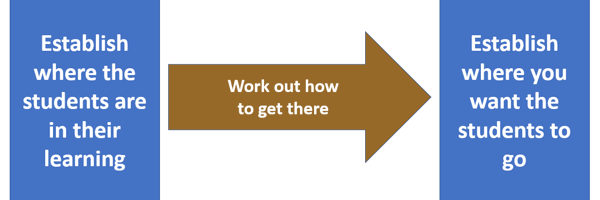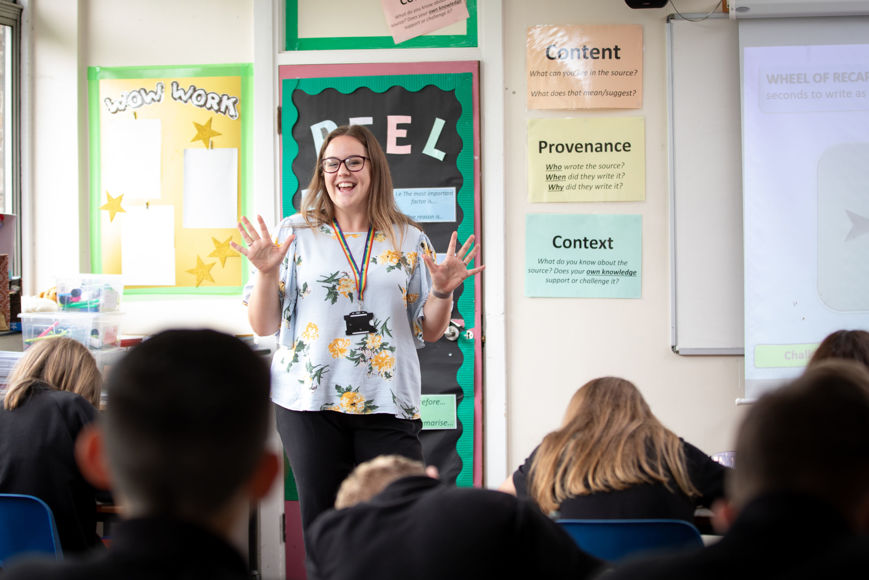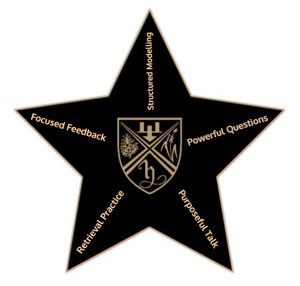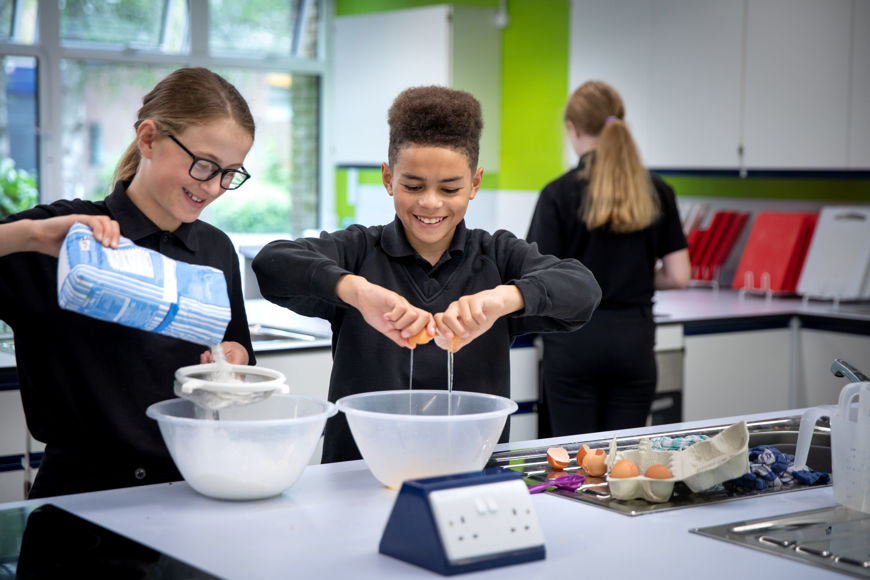Planning and implementation of learning activities
Rationale
Within departments, it is important that schemes of work are planned centrally to enable all students to access a curriculum that is both challenging and rigorous.
Teachers will shape their planning and deliver lessons to suit the needs of the students in front of them, enabling all students to work towards learning objectives and make good progress over time.
Lesson Planning
When devising lessons, the best practice is to use the following diagram to guide the planning and keep it focused.

In this way, teachers are:
- Ascertaining the starting point
- Identifying the learning objectives
- Planning activities that enable students to move forward and make progress.
DfE Teaching Standards
In line with the Department for Education’s Teaching Standards, teachers should strive to ensure that their planning allows for the following criteria to be met:
1. Set high expectations which inspire, motivate and challenge students - Progress data should be used to set tasks that are matched to students’ prior attainment. Students should be challenged to make progress at every opportunity.
2. Promote good progress and outcomes by students within lessons and over time - Lessons should be designed so that students make at least good progress in their learning relative to their ability and starting points, and demonstrate full understanding of this. This should be sustained over time.
3. Demonstrate good subject and curriculum knowledge - Teachers must draw upon their subject knowledge and keep up to date with curriculum changes and phase expertise so that they can address misunderstandings and maintain students’ interests.
4. Plan and teach well-structured lessons - Planned and structured lessons should lead to optimised pace and depth of learning, thus allowing students to make rapid and sustained progress. As part of this, homework should be set to extend, consolidate or re-visit prior learning.
5. Adapt teaching to respond to the strengths and needs of all students - Work for individual students should be adapted in the light of any misconceptions that are brought to light through questioning or checks on students’ work.
6. Make accurate and productive use of assessment – Written feedback should be regular and follow guidance from the T&L protocol so as to provide students with very clear guidance on how work can be improved. Students should be engaged in the process.
7. Manage behaviour effectively to ensure a respectful and safe learning experience - Strategies and tasks should be designed to engage students so that they persevere when faced with difficult problems and are keen to succeed and to learn more.
8. Fulfil Wider Professional Responsibilities, including the communication with and effective use of LSAs – Where appropriate, additional adults will be engaged in the planning and implementation phase of teaching and learning, to ensure that specific students receive additional support to ensure that they are able to make progress and secure good outcomes.
Implementation of learning activities
What does high quality teaching and learning look like?

The Hurst School staff are committed to continuing their professional development to ensure the best outcomes for the students in their care. Active engagement in up-to-date research and pedagogy is at the core of teaching and learning, and time is regularly prioritised for staff to reflect on these developments.
Whilst this is not an exhaustive list, The Hurst School recognises key aspects of effective teaching and learning. These features can be observed as normal, daily practice within classrooms:
- Engagement – students are involved and take active roles in being responsible for their learning.
- Pace – there is momentum that makes it apparent that learning objectives will be met.
- Challenge – activities are pitched appropriately to ensure that all students can move forward in their learning.
- Behaviour for learning – students’ behaviour is managed to not only show compliance, but to demonstrate a strong desire to learn.
The Hurst Way
Alongside these descriptors, ‘The Hurst Way’ identifies five key pedagogical approaches that should be employed in the implementation of teaching and learning.

1. Retrieval practice The deliberate recall of learnt information.
2. Powerful questions Allowing students to think deeply and thoughtfully about subject matter.
3. Purposeful talk Collaborative use of discussion to build confidence and refine ideas.
4. Structured modelling Expert physical and verbal instruction and demonstration.
5. Focused feedback Verbal and written feedback which identifies key learning points to move forward.
The Structure of the Lesson
Whilst there will be differences in the components of lessons, all lessons at The Hurst School will include the following 3 elements:
- Do Now
- Independent Practice
- Reflection
Do Now
At the start of every lesson, students will be given a ‘Do Now’ task to engage in immediately. This will ensure that the focus is on Teaching and Learning from the moment that students step into the lesson, and set the tone for appropriate behaviour for learning.
This task may take a variety of forms, including (but not limited to):
- A retrieval exercise
- A key question for thought
- A spelling test
- A piece of reading
Independent Practice
It is important that students are able to work both collaboratively and independently. To this end, in every lesson, teachers will plan an activity where students are asked to work by themselves in order to challenge and practice a specific piece of knowledge or skill. Teachers will pitch this at an appropriate level so that all students can attempt the task. In doing this, students will be encouraged to build their resilience as well as their independence. Often, this task will be done in silence.
In practical-heavy subjects, this part of the lesson may look a little different. Students may be paired so that they are able to practise a specific skill.
Reflection
Typically at the end of each lesson, but not necessarily so, students will be asked to engage in a reflection task. This is likely to cover the learning of the lesson, or a sequence of lessons, and will ask students to evaluate their progress so far and identify the areas that are less confident in. This may also include engagement in a Next Steps activity as part of responding to written or verbal feedback.
In this way teachers are actively involving students in the process of learning in order to improve their knowledge of how they learn.



